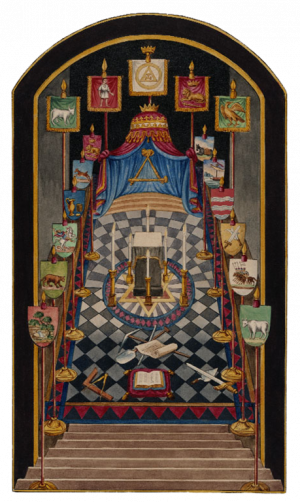Origins of the Royal Arch

The exact origins of the four Chapter degrees in its current form as part of the York Rite are unknown. As for the degree of Royal Arch Mason, Turnbull and Denslow contend that “It is the most widely known and talked about degree in the Masonic system” because it had been part of the third degree until the formation of the United Grand Lodge of England. Although glimpses of Royal Arch Masonry vocabulary appear in Masonic literature from the 1720s, the first verifiable appearance of Royal Arch Masonry is in Ireland in the 1740s during a Dublin procession. According to Lodge No. 21’s records, the “Royal Arch” was carried in a procession by “two excellent Masons” through Youghal, Ireland, on December 27, 1743. The degree is also mentioned disapprovingly in Dassigny’s “A serious and impartial enquiry into the cause of the present decay of Free-masonry in the Kingdom of Ireland” published in Dublin in 1744. Separate notes in this work indicate that the rite was practised in Dublin, London and York, and described it as an “organis’d body of men who have passed the chair” (i.e. served as the Master of a Craft lodge).
In 1749, the Grand Lodge of Ireland issued warrants to Lodges 190 and 198 to establish “Royal Arch Lodges”.
From Ireland, the Royal Arch spread to England, where it fuelled the rivalry between the two Craft grand lodges in existence at that time. In 1717 the original Premier Grand Lodge of England had been formed in London to govern Craft Freemasonry in England. From 1751, its claim to represent the whole of English Craft Freemasonry was contested by the Antient Grand Lodge of England. In the ensuing debate, the newer grand lodge became known as the “Antients”, while the older was referred to as the “Moderns”. In 1746, Laurence Dermott, later the Grand Secretary of the “Antients”, had been accepted into a Royal Arch Chapter in Dublin, which at that time was open only to those who had previously served as master of a Craft lodge. He regarded the Royal Arch as the fourth degree of Craft Masonry. Under his influence, the “Antients” championed the Royal Arch degree in England, while it was met with hostility in the “Moderns”.
At the beginning of the 19th century, when the “Antients” and the “Moderns” moved from rivalry towards union, the role and purpose of the Royal Arch became a sticking point. The “Antients” viewed the Royal Arch as a fourth degree of Craft Freemasonry and worked it as part of the Craft ceremonies, while the “Moderns” held that Craft Freemasonry consisted of three degrees only and that the Royal Arch was at the most an extension of the third (Master Mason’s) degree which was to be administered separately. When the “Antients” and “Moderns” merged in 1813 to form the United Grand Lodge of England, this was possible only after reaching a compromise on the role and purpose of Royal Arch Masonry. After the union, the “Supreme Order of the Holy Royal Arch” would be fully recognized by the United Grand Lodge, but become a separate order with all Craft Lodges permitted to work the ceremony.
